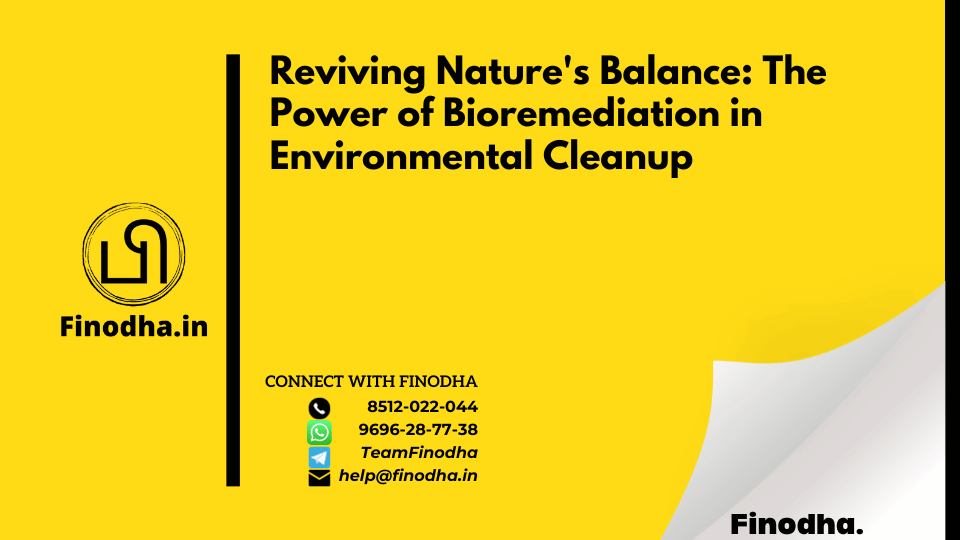Important Keywords: Bioremediation, Pollution Cleanup, Environment, Microorganisms, Sustainable Solutions, Eco-Friendly Cleanup.
Table of Contents
Introduction: Bioremediation
In a world grappling with environmental concerns, the concept of bioremediation emerges as a beacon of hope. It’s a technique that employs nature’s finest, bacteria and fungi, to cleanse our surroundings from contamination. The beauty lies in its simplicity – harnessing the inherent capabilities of these microorganisms to transform hazardous substances into harmless compounds. Let’s delve into the fascinating world of bioremediation, its types, and how it’s making waves in the restoration of our planet’s ecological harmony.
The Bioremediation Advantage:
1. Nature-Friendly Cleanup:
- Utilizes natural processes and organisms to clean up pollutants, minimizing harm to the environment.
2. Cost-Effective:
- Generally a more economical option compared to traditional cleanup methods, particularly in the long run.
3. Soil and Water Restoration:
- Efficiently targets contaminated soil and water, rejuvenating these essential resources for a sustainable ecosystem.
4. Versatility:
- Applicable to a wide range of contaminants, from oil spills to heavy metals, showcasing its versatility and adaptability.
Types of Bioremediation Techniques:
In situ methods:
- Bioventing:
- Stimulates microbial growth in contaminated soil by supplying air and nutrients, aiding in hydrocarbon degradation.
- Biosparging:
- Pressurized injection of air below the groundwater table to enhance biological degradation, especially useful for groundwater contamination.
- Bioaugmentation:
- Introduces specific microorganisms to the contaminated area to carry out targeted remediation tasks.
Ex situ methods:
- Composting:
- Mixes contaminated soil with organic material, encouraging microbial growth and speeding up degradation.
- Land Farming:
- Spreads polluted soil over prepared beds with microorganisms, allowing natural degradation while minimizing relocation.
- Biopiles:
- Utilizes engineered compost pits to treat surface contamination by hydrocarbons through composting and land farming.
- Bioreactors:
- Employs engineered containment systems for treating contaminated soil and water.
Unveiling the Magic: A Relatable Example
Imagine a polluted river in a bustling Indian city, suffocated by years of industrial waste. Bioremediation steps in as a hero, utilizing natural bacteria to break down the pollutants, purifying the river. Picture the once-toxic waters now thriving with life, a testament to the power of biological cleanup.
Key Insights and Learnings:
- Bioremediation offers a sustainable, nature-driven solution to environmental contamination.
- Its advantages lie in cost-efficiency, eco-friendliness, and applicability across various pollutants.
- With appropriate techniques, it holds the promise to restore the natural balance of our planet.
Conclusion:
Bioremediation epitomizes the marriage of science and nature, presenting a solution to our environmental challenges. By harnessing the inherent power of microorganisms, we can pave a cleaner, healthier path for our planet. From contaminated soils to polluted water bodies, this innovative approach is making strides in revitalizing our natural resources. Let us embrace the potential of bioremediation and stand witness to a greener, more sustainable future.
-
Investing Essentials: A Beginner’s Guide to Smart Money Moves

Investing essentials constitute the fundamental principles and knowledge areas that every individual should understand before embarking on their investment journey.
-
NOTIFICATION No. 31/2024–Central Tax: Seeks to appoint common adjudicating authority for Show cause notices issued by officers of DGGI

S.O…(E).— In exercise of the powers conferred by section 5 of the CGST Act, 2017 (12 of 2017) and section 3 of the Integrated Goods and Services Tax Act, 2017 (13 of 2017),
Popular Tags:
Capital gains (21) CGST (280) Chapter VI-A (15) e-Compliance Portal (21) E-Verify (20) economic growth (20) F&O Trading (29) F.No.354/117/2017-TRU (23) F. No. CBIC-20001/4/2024-GST (15) Financial planning (15) financial stability (16) GST (1458) IGST (223) Income from House Property (17) Income Heads (16) Income Source (14) Income tax (110) Income Tax Account (15) Income Tax Filing (20) Indian context (22) Indian investors (16) ITR-3 (19) ITR Form (20) P&L Statement (24) PAN (13) Risk Management (20) Salary Income (19) Section 7(1) UTGST Act 2017 (14) Section 8(1) UTGST Act 2017 (26) section 9 (18) section 10 (28) section 15 (13) section 25 (17) section 39 (24) section 49 (16) section 50 (16) section 51 (13) Section 52 (16) Section 54 (13) section 73 (21) section 74 (22) SGST (223) Speculative Income (14) Trading Income (33) UTGST (78)


